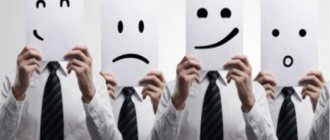Psychologists call character a combination of personality traits that determine its behavior. You can make many lists of human character traits. If two people are given the task of characterizing a third person, their lists will differ from each other. People don't think about how character affects their successes or failures. But, considering the individual qualities that make up character, it is easy to understand how they affect the personality as a whole. A person’s character traits develop depending on the type of nervous activity, heredity, and upbringing environment. They are formed throughout life. The predominance of certain traits determines a person’s lifestyle.
What is character?
- Character, personality, personality refers to the sum of characteristics that a person possesses. Character refers primarily to moral qualities, ethical standards, principles and the like; a man of impeccable character.
- Individuality refers to the distinctive qualities that make a person recognizable as an individual different from others; a woman with a strong personality.
- Personality refers to the combination of external and internal characteristics that determine the impression a person makes on others: a child with a bright or pleasant personality.
Adjectives that can describe a person's face
The face plays a very important role in a person's life. After all, this is the first thing that others pay attention to. Naturally, a beautiful person should be like that inside and not boast about his appearance. An internally beautiful personality will leave an indelible impression on those who have ever had contact with her.
By looking at the face, you can immediately determine whether a person is cheerful or not, what kind of mood he is in, and what kind of life he has lived. After all, a face is like the cover of a book.
When describing a person’s face, you can pay attention to its shape, color, location of the eyes and eyebrows, and so on. Everyone knows that face shape can be round, oval, square, triangular, diamond-shaped, trapezoidal and elongated. The color of a face can be dark, white, pink, tanned, red, freckled, and so on. There are also different types of faces: European, Mongolian and Caucasian.
What kind of character does a person have?
Correct assessment begins with determining what types of character people have. All traits are distributed into five main groups:
Social
It includes traits determined by attitude:
- to yourself;
- labor;
- to society.
Emotional
It includes:
- expressiveness;
- impressionability;
- cheerfulness;
- high and low emotionality;
- impulsiveness;
- impressiveness;
- unstable emotionality.
Strong-willed
It includes:
- focus;
- determination;
- persistence;
- uncertainty;
- courage;
- discipline;
- independence.
Intelligent
It includes:
- prudence;
- depth and flexibility of intelligence;
- resourcefulness;
- mindset (practical or theoretical);
- frivolity;
- intelligence;
- curiosity;
- thoughtfulness.
Moral
It includes the following features:
- rigidity;
- kindness;
- responsiveness;
- honesty and similar qualities.
To compile a psychological portrait, certain qualities are noted.
The word as a means of information exchange
The real life of every person begins with a word. It is a good means for exchanging information. When the baby says something similar to a word for the first time, parents rejoice endlessly. After all, this means that a new member of society has appeared, who will have an interesting, rich life. With the help of words, people can communicate with each other. Also words play a big role in description. For example, adjectives that characterize a person help to learn in detail about the qualities of a person, the properties of his character and behavioral characteristics. Also, the word is a means of achieving goals, because if a person knows how to speak well, he will comprehend the minds of others. Thanks to this means of exchanging information, you can have the closest and most reverent relationships, and feel whether a good or evil person is nearby. You can understand the essence of your interlocutor, find out what is in his heart, with the help of words.
What are the character traits of a person?
The positive ones include:
- adequacy, altruism, activity;
- fearlessness, frugality, prudence, nobility;
- generosity, good manners, politeness, attentiveness, cheerful disposition, will, high morality;
- humanism, gallantry, harmony;
- friendliness, delicacy, conscientiousness, discipline, foresight, diplomacy, efficiency, kindness, good nature;
- naturalness;
- femininity, cheerfulness;
- caring, thrifty;
- ingenuity, initiative, diligence, sincerity, intelligence;
- creativity, sociability, correctness, culture, competence, collectivism, eloquence;
- curiosity, affection, ease of communication;
- wisdom, masculinity, peacefulness, dreaminess;
- tenderness, independence, reliability, observation, resourcefulness;
- experience, sociability, charm, education, caution, responsibility, neatness, responsiveness, talent, objectivity;
- decency, positivity, practicality, understanding, friendliness;
- decisiveness, romance, cordiality;
- self-criticism, modesty, intelligence, conscientiousness, independence;
- tactfulness, hard work, desire for creativity, patience;
- smiling, perseverance, poise, respectfulness, perseverance, courtesy, perseverance;
- thriftiness, charisma, courage;
- chastity, determination;
- sincerity, honesty, sensitivity;
- generosity, playfulness;
- energy, economy, enthusiasm, empathy, erudition.
Negative qualities include all the antipodes of the listed traits.
For example:
- aggressiveness;
- vulgarity;
- impudence;
- envy;
- arrogance;
- deceit;
- commercialism;
- narcissism;
- touchiness;
- selfishness;
- callousness, etc.
Every positive trait has an opposite meaning. However, there are some qualities that can be called neutral:
- shyness;
- silence;
- assertiveness;
- shyness;
- daydreaming.
For some people these are positive qualities, for others they may be negative. For example, assertiveness. In business it is sometimes necessary, but in personal relationships it sometimes gets in the way. Shyness is good for a girl, but is perceived negatively when it appears in a young man. When drawing up a psychological portrait, all of the above positive qualities, their antipodes and other features are taken into account.
Describing a human figure using adjectives
Adjectives that describe a person can also help describe their figure. The formation of a person’s figure does not depend on his gender, but on the ratio of height, skeletal structure and deposition of subcutaneous fat.
If we talk about a person’s height, he can be short, medium, high and very tall. But the body type can be thin, average, plump, corpulent, plump, well-fed, stocky, stooped, hunched, athletic, slender, thin and skinny. A person can also be broad-shouldered, broad-shouldered or narrow-shouldered, and sloping shoulders are also possible. For example, a fat person may even have narrow shoulders.
Manifestation of character and temperament
A person’s character is not formed instantly, but until old age. The social environment is of great importance. For example, the volitional qualities inherent in a person manifest themselves in emergency situations when endurance, courage, stubbornness, etc. are required.
Emotionality is mental manifestations that arise in certain situations. In this case, feelings can be negative or positive, dynamic or stable, neutral. If we talk about intelligence, then this includes the individual characteristics and quality of thinking of an individual. For example, criticality, stupidity, breadth of soul, flexibility in any relationship, etc.
The character of people greatly influences their perception of the environment. Some consider everyone good or bad, others only themselves. Each person has a certain attitude:
- to oneself (self-esteem, self-criticism, self-respect, etc.);
- labor (punctuality, accuracy, negligence, etc.);
- environment (politeness, isolation, sociability, rudeness, etc.).
As a result, a certain temperament is formed. It includes qualities that are constant for a particular person:
1. Sanguine people are very mobile and efficient, but they quickly get tired of hard work. They have bright facial expressions and strong expressions of emotions. They are sociable, responsive, balanced. They look at everything from a positive point of view and are optimistic. They have a cheerful disposition.
2. Cholerics are characterized by sudden mood swings, hysteria, and impetuosity. They have frequent outbursts of anger, short temper, but quick release.
3. Melancholic people are pessimists, they worry excessively about any reason, and are often in an anxious state. Such people are very distrustful of others, vulnerable, reserved, and have good self-control.
4. Phlegmatic people have very low activity. However, they are very reasonable, cold-blooded and prudent. Any task is always completed.
Separately, it is worth noting that each nationality has its own character traits, although there are many common features. The greatest diversity is among the Russians.
Their character is very different from other nationalities.
Main criteria:
a) Spiritual generosity, which most nationalities do not have. b) Compassion.
c) Craving for justice.
d) Patience, endurance, perseverance.
e) Negative qualities include pessimism, foul language, laziness, hypocrisy. The positive ones are responsiveness, loyalty, compassion, humanity.
Russians are easily distinguished by a combination of character traits, one of which is a special sense of humor, which other nationalities are not always able to understand. The set of qualities is so diverse that most people experience excessive expression of emotions. Some traits may change throughout life. However, other qualities remain unchanged. However, negative traits are not always regarded as negative. Sometimes they emphasize dignity.
For example:
1. Selfishness is not only ignoring other people, but also putting one's own interests first. Such a person has his own opinion and will not follow the lead of others.
2. Self-confidence can improve productivity and performance. Then the person feels self-satisfied, which ultimately brings positive results for society.
3. Envy sometimes pushes a person to work better and achieve the best result.
4. Stubbornness helps you achieve any goals you set.
The character of any person consists of positive and negative qualities. As a result, a certain type is formed. For example, a person can be lazy, but kind and sympathetic. The other is angry, but very hardworking and aspiring. At the same time, women are always more emotional, selfless, good-natured, and patient. Men are most often reserved, decisive, and responsible.
What are the types of temperament?
We figured out what character is. These are personal characteristics of a person that are formed from birth. It is often confused with temperament , although these concepts are far from the same thing.
Temperament is a property of the nervous system: its mobility, responsiveness, stability. This quality of an individual is innate and, unlike character, cannot be changed.
Temperament can be thought of as the basis on which character will subsequently be formed, with the former significantly influencing the latter. Hippocrates wrote about the types of temperament; psychology adheres to his classification to this day:
- melancholic – an anxious person who does not cope well with stress due to a mobile nervous system;
- sanguine – balanced, logical, lively, sociable, optimistic;
- choleric – explosive, impulsive, hot-tempered;
- phlegmatic (who is this?) – a stable, hardy personality type, calm and measured.
Human character traits (weaknesses and strengths)
| Character Strengths | Character Weaknesses |
| Brave | Reckless |
| Idealistic | Naive |
| Funny | Frivolous |
| Confident | Arrogant |
| Careful | Timid |
| Virtuous | Hard |
| Open-minded | Excessive |
| Definite | Stubborn |
| Loyal | Ostrovny |
| Modest | Passive |
| Patient | Unproductive |
| Vigorous | Exhausting |
| Independent | Outsider |
| Figurative | Unrealistic |
| Charismatic | Self-centered |
| Emotional | Illogical |
| Proud | Conceited |
| Managed | Greedy |
| Logical | Unempathetic |
| Honest | Blunt |
| Decisive | Impulsive |
| A born leader | Imperious |
| Concentrated | Addictive personality |
| Curious | Aimless |
| Kind | Unassuming |
| Principal | Intolerant |
| Charming | False |
| Adaptable | Structureless |
| Realistic | Cynical |
Can you remember what I missed? Leave a comment and I'll add them to the post!
What adjectives can describe people's limbs?
Legs and arms have always played a vital role in human life. Everyone lives and doesn’t think about the fact that we have them. But if some tragedy happens and a person is left without them, he begins to appreciate what he has lost.
A fat person may have plump limbs. Slender - thin. Legs, for example, can be long or short, slender or low. But if we talk about the shape of the hand, then you can find out something interesting for yourself. For example, the hand can be elementary, square, spatulate, philosophical, artistic, idealistic and mixed. Thin fingers on the hands of an adult indicate the activity that he performs. Very often these are violinists or surgeons.
Adjectives describing a person's intelligence and abilities
Intelligence and abilities are what distinguishes a person from an animal. The level of intelligence can always be developed, and every person can become the best. To do this you need to work on yourself. An evil person, being jealous of others, will never be able to become smarter and improve. He remains at the level he is at at the moment. In terms of intellectual development, a person can be smart, stupid or moderately developed.
But everyone has their own abilities. It is important to note that from childhood you need to try to detect them and direct them in the right direction. After all, if this is not done, a person may regret an unrealistic dream all his life. Abilities can be associated with activity, knowledge, talent, genius.
Primary traits
A characteristic that is always characteristic of a person is called a primary character trait. Such a trait does not have to manifest itself in any case, however, it is there, and it is well expressed. For example, a sociable person may not show his sociability in some cases, this does not negate his ability to find a common language with people and become the center of attention. Why is it important? An employee who has such a primary trait as conscientiousness at work may be slack and negligent, but an employee who cannot boast of such a trait will be more likely to slack. Therefore, when you predict a person's long-term behavior, primary traits are the basis of the prediction. If they are not revealed, then there are obstacles that can be found and eliminated.
- goodwill – conflict;
- diligence - a tendency to idleness;
- initiative - inertia;
- communication skills - isolation.
What adjectives can express emotions?
Emotions are what accompanies people every day. This special type of mental processes or human states manifests itself in the experience of significant situations, phenomena and events throughout life.
When listing the emotions characteristic of a person, one can get confused, since the list of such will be long. Among the main and positive ones, one can distinguish a person who is joyful, funny, reliable, grateful, caring, gentle, submissive, aspiring, reverent, satisfied and energetic.
Also, when describing the emotionality of people, we can highlight those emotions that prevent a person and those around him from living. This is a person who is touchy, whiny, indignant, arrogant, proud, envious, crafty, impatient, always suffering and fearful.
Appearance in English
While learning English, each of us at some stage is faced with the need to describe the appearance of a person: ourselves or a friend, an acquaintance or a stranger. And if you started learning English in courses (or earlier, at school), you are well aware that this “topic” is one of the first conversational topics (And how the class laughed when someone confused the words eyes and ears when he wanted to say in English “She had big blue eyes”? Oh, those were golden days).
The ability to correctly and completely describe a person’s appearance (physical appearance or, less formally, looks) is very valuable both in itself and from the point of view of the organizers of all kinds of English exams (TOEFL, IELTS and others like them). Without mastering this topic, you are unlikely to be able to win the examiner’s heart: the story or essay “About myself” has become a classic exam topic.
Do you want to amaze the examiners (friends, colleagues, grandmother, girlfriend) with your knowledge of an incredible number of epithets that describe a person’s appearance? Read on!
About myself, beloved
So, you were asked a question:
What do you look like? (What do you look like?) or How would you describe your physical appearance? (How would you describe your appearance?)
Alas, in a story about one’s own appearance, it is not customary to describe in detail the expression of the eyes and the shape of the eyebrows, the gracefulness of posture and the impressiveness of the gait. Describe your appearance in general terms, as they say, in broad strokes: the color of the hair, eyes and skin, height and build. You can also add a few words about what style of clothing you prefer.
Keep in mind that during a job interview a very similar question is asked: How would you describe yourself? It, however, refers to your emotional, volitional and business qualities: in response, you must indicate your “strengths,” that is, personal and professional characteristics that will help you succeed in your work.
Describing a person's appearance in English
But if you were asked a question:
How does he/she look? (What does he/she look like?) or How do they look? (How do they look?),
you can apply a much wider range of definitions (see later in our article).
First (classical):
| Pronoun | + to be | + sign | |
| (verb in personal form) | (adjective) | ||
| I | (I) | am | tall. |
| He, she | (He she) | is | tall. |
| You, we, they | (You, you, we, they) | are | tall. |
| I am slender. | I'm slim. |
| She is short. | She is not tall. |
| He is slightly overweight. | He's a little plump. |
Second (more typical for conversational style):
| Pronoun | + to have got | + sign | |
| (verb in personal form) | |||
| I | (I) | have got (abbr.: 've got ) | big blue eyes. |
| He, she | (He she) | has got (abbr.: 's got ) | big blue eyes. |
| You, we, they | (You, you, we, they) | have got (abbr.: 've got ) | big blue eyes. |
| I have got red hair (or I've got red hair). | I have red hair. |
| She has got green eyes (or She's got green eyes). | She has green eyes. |
| He has got a beer belly (or He's got a beer belly ). | He's got a beer belly. |
THIS IS INTERESTING: What are collective nouns
In our article “Names of human body parts in English” you will find not only the names of human body parts and organs, but also 10 funny “bodily” idioms.
Together with epithets denoting a person’s appearance, you can use adverbs of degree (measure) - degree modifiers: rather, quite, enough, pretty - quite, enough, very - very and too - too:
| She is rather tall. | She's quite tall. |
| He is very strong. | He is very strong. |
Let's sing, friends! A children's song about how to describe yourself and your friend:
It turns out that it is so simple - even children can do it! And for those who decided to dig deeper:
Characteristics of appearance - words describing the human body
In the English language there are a huge number of epithets with which you can describe a person’s appearance.
Below we provide a fairly extensive list of various characteristics of the human body. Use this vocabulary to expand your vocabulary: it will be useful to you not only in oral speech when you need to describe yourself or another person, but also when writing an English essay on the topic “About yourself,” “About a friend,” or “A person’s appearance.”
Arms - Arms (from shoulder to wrist)
| Bony | Bony |
| Lank, lanky | Skinny |
| Long | Long |
| Rounded | Rounded |
| Short | Short |
| Well-shaped | Relief, well defined |
Bearing - Posture
| Bear oneself well | Have good posture |
Negative human qualities
Rare parents deliberately cultivate negative qualities in their children. The latter are formed as a reaction of the child’s psyche to the environment in which he lives. Where there is no love, indifference reigns - poisonous flowers of selfishness, laziness, and disorganization grow. Such character traits make a person unlucky. When aggression and depravity rule the roost in a family, children develop meanness, greed, and cruelty—they grow up unhappy.
- Gambling
- Weakness
- Facelessness
- Addiction
- tediousness
- Pettiness
- Greed, stinginess
- Spoiled
- windiness
- Flattery
- Indifference
- Apathy
- Jealousy
- Alarmism
- Complexity
- Lust for power
- Ruthlessness
- Disorderly
- Arrogance
- Self-criticism
- Stubbornness
- Authoritarianism
- Hypocrisy
- Irresponsibility
- Touchiness
- Self-confidence
- Aggressiveness
- Greed
- Deceit
- Selfishness
- Cruelty
- Vanity
- Suggestibility
- Irritability
- Laziness
- Impudence
- vulgarity
- Stupidity
- Rudeness
- Narcissism
- Cowardice
- Pride
- Forgetfulness
- Anger
- Annoyance
- Coarseness
- Extravagance
- Curiosity
- Negligence
- Vindictiveness
- Vulgarity
- Talkativeness
- Envy











